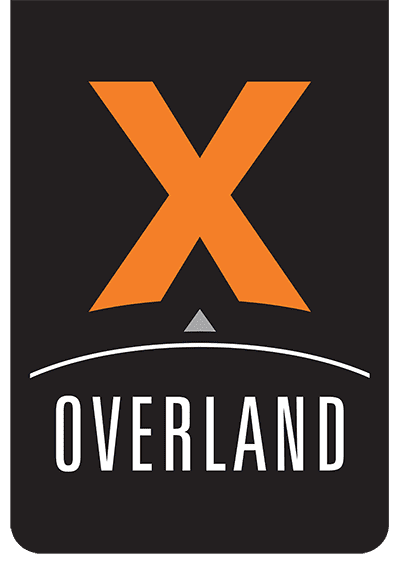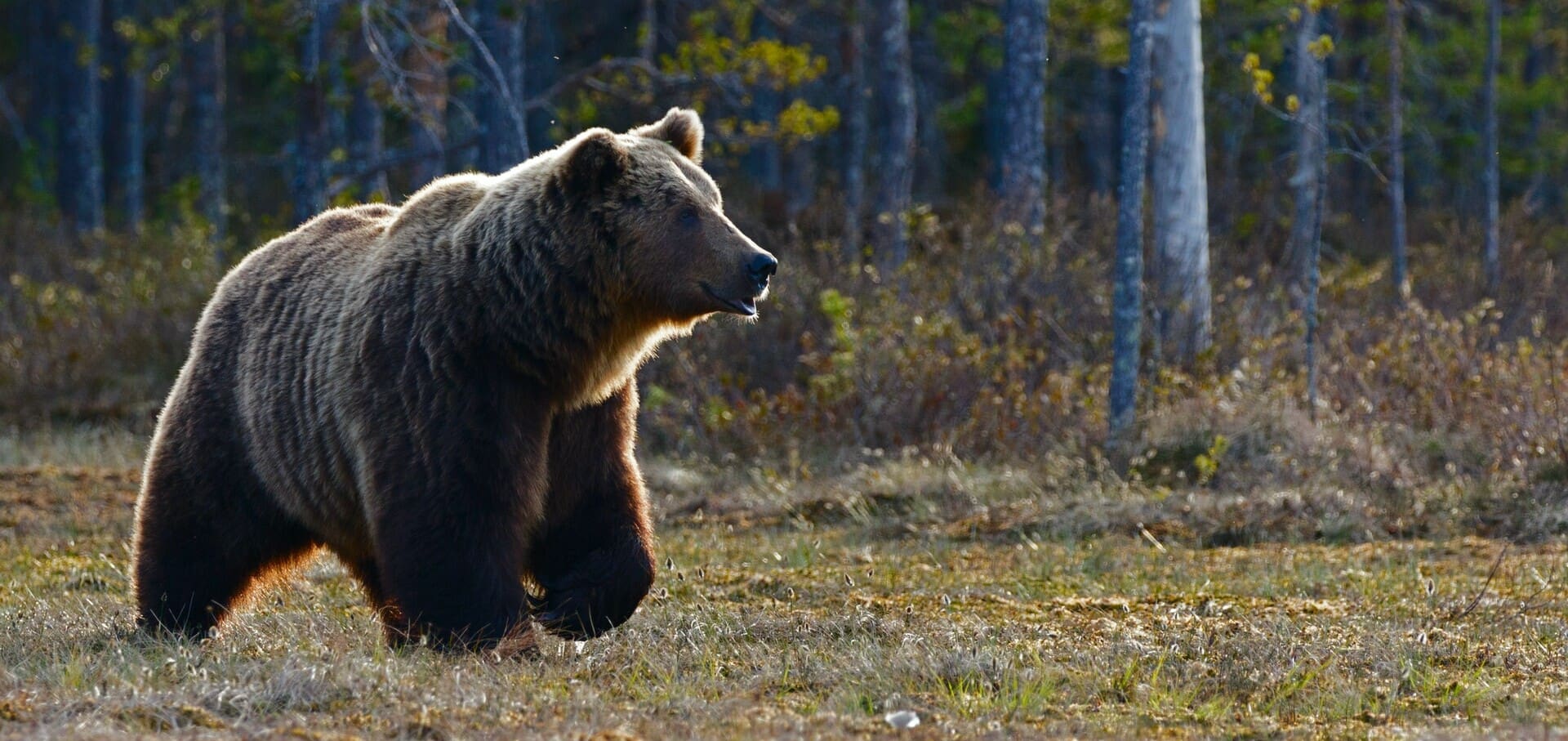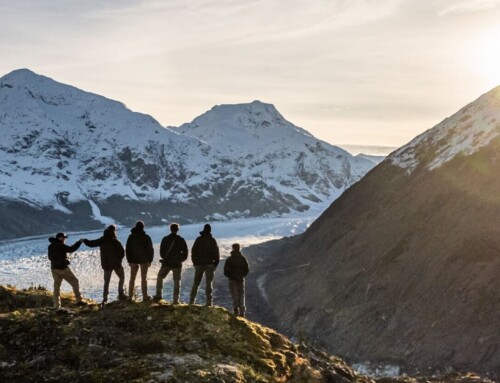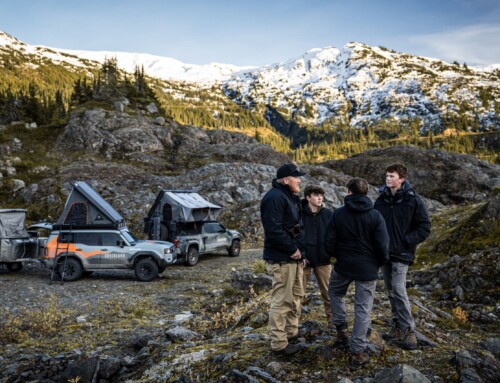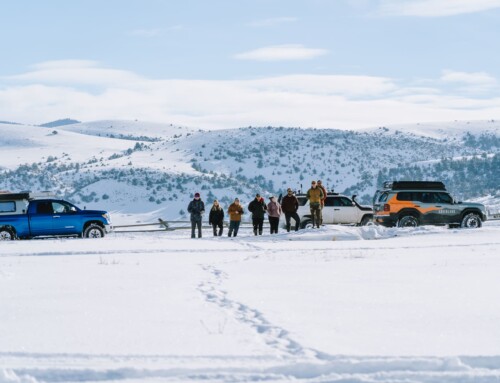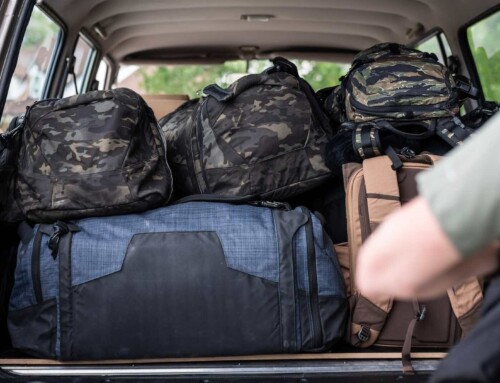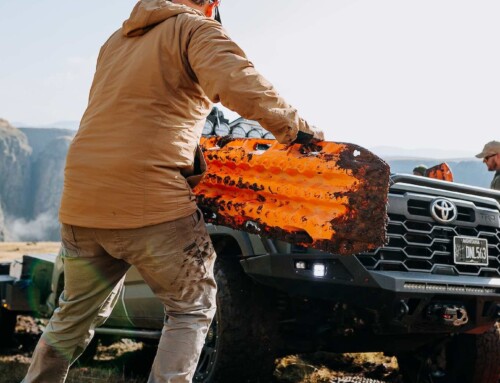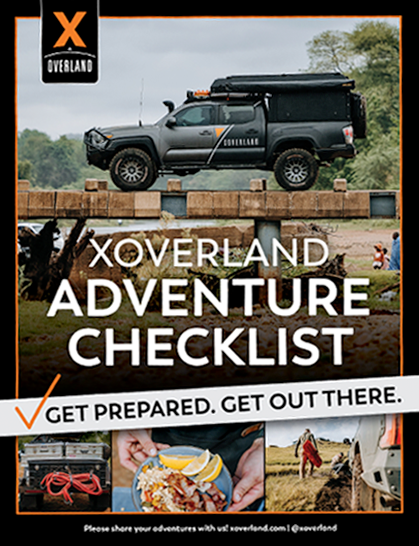As overlanders, we seek out remote, unspoiled landscapes where we can find exciting trails and primitive campsites in pristine environments. Of course, our desire to get off the grid and into beautiful spaces often places us within the proximity of wild animals.
While most of us desire to experience the thrill of seeing these amazing creatures in their natural habitat, we don’t wish to experience seeing them up too close, especially within our campsites where conflicts could ensue that could become dangerous to ourselves and the animals we’re encountering.
“BEAR COUNTRY”
Among the huge variety of animals overlanders might encounter on the trail, bears–especially Grizzly Bears–give us pause to consider the measures we are taking to prevent a destructive and/or dangerous situation from developing.
In addition to our own subjective concerns, there are numerous laws and regulations affecting how we can camp and recreate on public lands which serve as prime habitat for bears, Grizzly Bears in particular.
In the region surrounding Bozeman where XOverland is headquartered, five out the seven regional forest districts within the Custer-Gallatin National Forest have stringent food ordinances in effect concerning camping and recreating in designated “Bear Country.”

(Photo Source: Interagency Grizzly Bear Committee) Be aware that when camping in bear country–especially in Grizzly Bear habitat–you are likely to encounter stringent food storage laws.
Wherever you intend to overland, be sure to do your homework to identify the laws and regulations affecting where and how you intend to camp in bear country. These laws often vary widely even on federal lands, and individual states have ordinances which affect state-owned and managed recreational lands differently from federal parcels.
Pro-Tip: Before you go, know who or what owns the land through which you’re overlanding. This is especially the case when it comes time to choose a campsite. We prefer onX Offroad to assist us in finding usable trails and legal camping areas.
BEAR COUNTRY IN THE LOWER-48 VS. ALASKA: LEGAL DIFFERENCES
The differences between Alaska and the lower-48 of the U.S. pertaining to legal guidelines affecting camping and recreating in designated Grizzly habitat is due to this important fact: Within the lower-48, grizzlies are designated by the U.S. Fish and Wildlife Service as a “Threatened Species,” a fact which results in very strict legal protocols surrounding all aspects of how this bear is managed and prevents states from forming their own more liberal management plans for these animals.
What you need to know is that if you kill a Grizzly Bear, you will be tried in court to determine whether or not you acted in self-defense of human life. If it can be proven otherwise, you will pay a hefty fine and likely go to jail. (Fines are up to $50,000 and jail time could be as much as a year.)
We have found that with proper planning and gear preparation, it is possible to effectively meet the legal requirements for camping in legally designated “Bear Country” wherever you find yourself: Alaska, Canada, or within the lower-48 states.
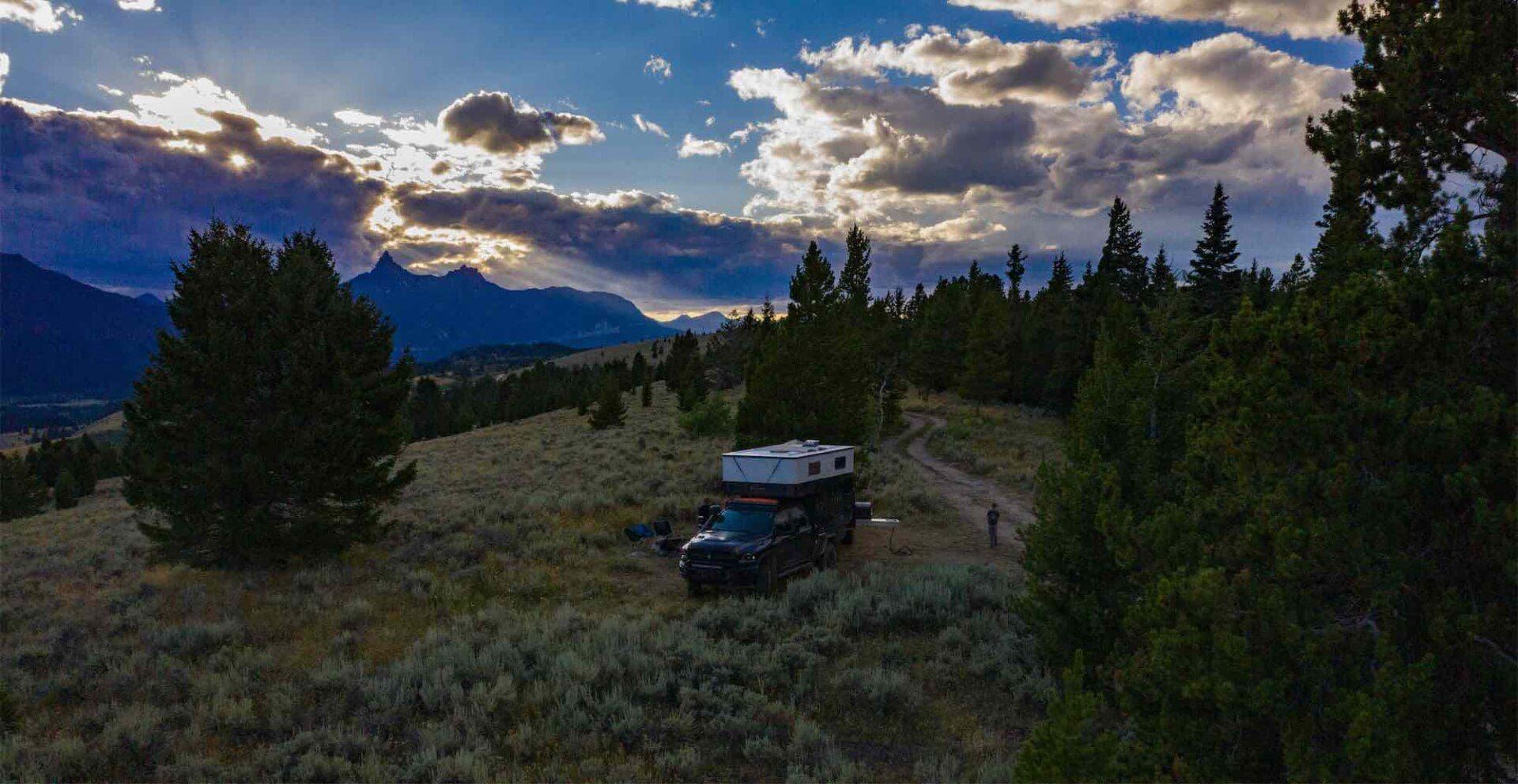
Bear Country is all around us in Montana and it’s a beautiful place to camp and travel!
Regardless of the legal ramifications of getting on the wrong side of the law when camping and recreating in grizzly country, the consequences alone of a destructive encounter with a bear–Grizzly or otherwise, may result in a wide variety of negative outcomes for an overlander, most of which will prove not just unpleasant but likely trip-altering or, in extreme cases, life-altering, as in a catastrophic encounter with a Grizzly that may prove severely injurious or fatal to those involved.
So let’s take a close look at how, as an overlander traveling through bear country, you can stay safe, legal, and improve your odds of avoiding a dangerous and/or destructive encounter with a bear.
DESTRUCTIVE BEAR ENCOUNTERS
In contrast to a dangerous encounter with a bear, a “destructive” encounter is much more likely and can be considered for our purposes here to be an incident in which the encounter with the bear proves destructive to gear, food, and equipment only. Meaning you stay safe and free from harm while your gear, equipment, and food gets destroyed and/or devoured. (Indeed, you may be out hiking or fishing for the day oblivious to the fact that a bear is back at your campsite having his way with your galley and food!)

(Source: Idaho Fish and Game) More likely than being life-threatening, a bear in camp is more apt to be destructive to your gear, equipment, and food supplies.
There are degrees of destruction: a cooler destroyed, a tent shredded, an overlanding system ravished. Regardless, it is better to avoid any destruction to your campsite at all, right? For both the bear’s sake and yours. The bear is much better off if not habituated to human food; you are better off if your overlanding gear, equipment, and food is fully intact so you can comfortably continue on your journey. So let’s look at how we can avoid having a bear maurade our campsite while we’re out on the trail.
CREATING A BEAR-PROOF CAMPSITE
Choose Your Campsite Carefully
Research shows that, ironically, bears are more likely to frequent an established campsite than a remote, more primitive site. Why? Because bears are smart. Once they find easy pickings for camp food, they’re likely to keep an eye on that place and plan their shenanigans accordingly.
This is a win for overlanders because we like to find special places to camp off-the-grid, in remote locations with more primitive surroundings. If bears aren’t used to finding food in these places, they’re far less likely to habituate them.
That means, however, if you find such a place, truly do your best to leave no trace (not even crumbs). That way the camp will be less likely to attract bears and critters of all kinds after you leave. Keep the same in mind when choosing your campsite. If it has significant litter and food debris and residue strewn about, perhaps move along and look for a cleaner site.
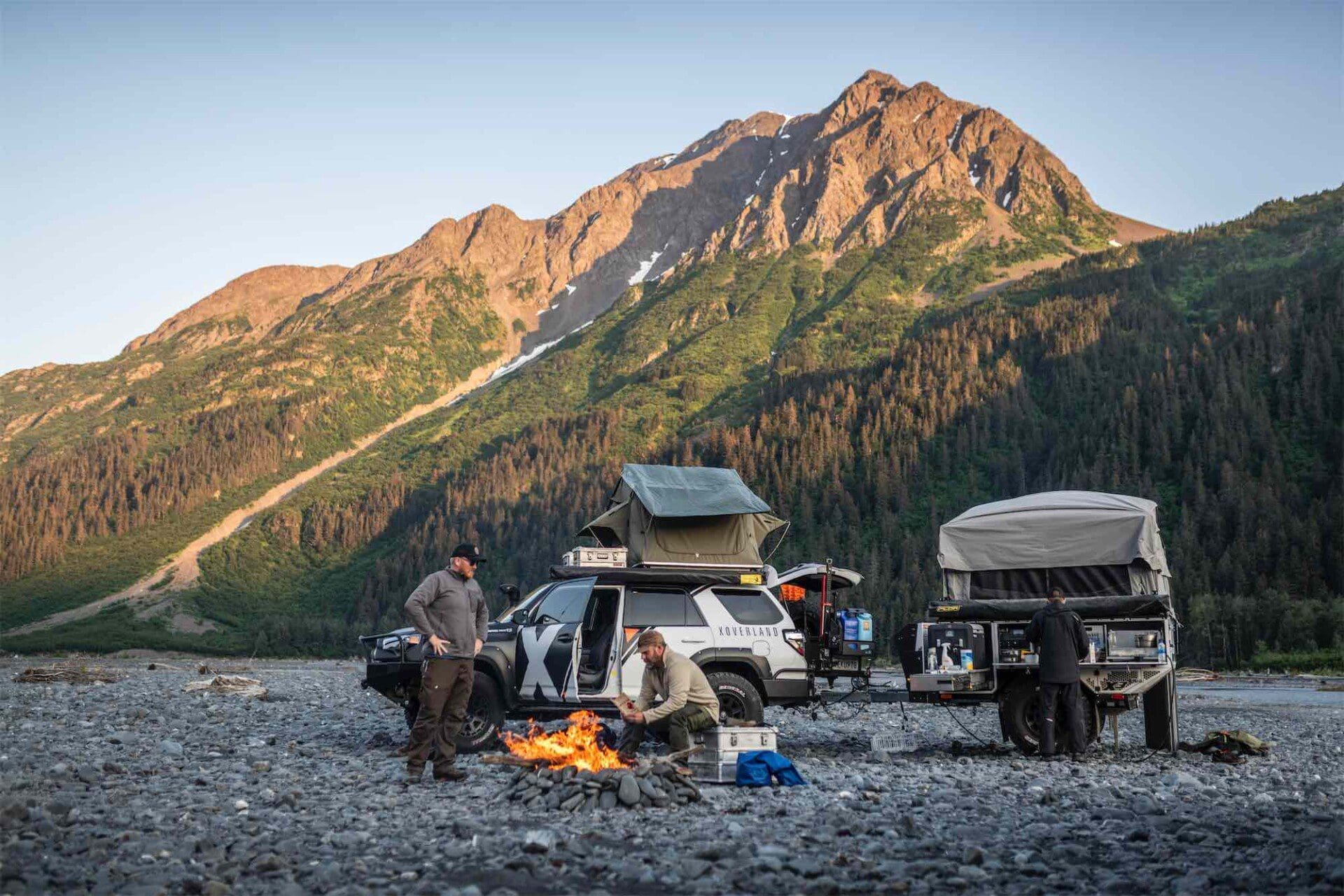
If possible, choose a campsite in a clear open area away from heavy brush and where visibility is good.
Next, make sure that your camp isn’t located in heavy brush and/or right next to a major game trail that bears are likely to go strolling along at night. Additionally keep an eye out for ripe berry patches that serve as prime feeding areas for bears.
Finally, before pitching your tent, take a walk around the area and look for bear sign: tracks, droppings, flipped rocks and logs (evidence bears have been feeding by looking for grubs), and bear scrapes on trees (around 5-7 feet)
If all of the above checks out, you’re ready to make camp!
BEAR-PROOF YOUR CAMP
Ok, so “bear-proof” may be a stretch, but there is a lot you can do to minimize the chance of a bear problem in camp.
Proper Food Storage
Bears have noses like sharks in that they can sniff out possible food sources from great distances. Once they catch the scent of something they deem tasty, they will probably make a move toward it.
While it is obviously impossible to mask cooking scents while we’re making a delicious meal, what we do after is the key to keeping a bear and critter proof camp. Also, it is worth keeping in mind that when you’re in heavy Grizzly habitat, you could always do the following to improve your odds of not having a bear visit your campsite after dinner:
- Eat a freeze-dried meal for the night. These meals involve no cooking and you can easily either burn the waste in the campfire (make sure the bag is labeled as compostable) or you can store it in a certified bear-resistant container. Bonus for overlanders: Aluboxes are certified by the Interagency Grizzly Bear Committee (I.G.B.C.) to be “Bear-Resistant.” If you don’t use Aluboxes, there are plenty of available I.G.B.C. certified bear-resistant containers available. (See the resources links below.)
- After cooking dinner, pack up and drive a few miles before making camp. Just make sure you are driving upwind!
Don’t forget that most of the time mice, squirrels, raccoons, skunks, and birds are more likely to cause problems in camp than bears. Keeping a good clean camp is simply best practice no matter where you’re camping. Who wants ants and mice coming around after dinner?

(Source: Bearvault.com) One approved means of storying food in bear country is by means of a “Bear-Resistant” container certified by the I.G.B.C.
If fire conditions warrant it, make sure to burn all food waste that “can be completely consumed by fire.” That phrase is in quotes because it is taken from the Custer-Gallatin National Forest food order affecting our local camping. That means no food/waste residue can be left to collect on the surface of the fire pit or seep into the ground in and/ore around it.
In designated bear country with large populations of Grizzlies in the lower-48 the leftover food item or waste that cannot be completely consumed by fire must be either safely stored in a I.G.B.C. certified bear-resistant container or hung above the ground with a “Bear Hang” according to legal parameters. (See current guidelines from the U.S. Forest Service here.) Again, good news for overlanders is that Aluboxes and Zarge boxes are certified by the I.G.B.C. to be “Bear-Resistant,” meaning they are legal to use as storage containers in areas where the U.S.D.A. has instituted strict food storage orders.
Cold Food Storage in Bear Country
Speaking of bear-resistant storage solutions, Yeti and Canyon Coolers (along with a host of other companies) designs and manufactures I.G.B.C. Certified Bear-Resistant coolers which can be effectively and legally used for food storage when combined with a padlock.
But what about the fact that many overlanders utilized powered refrigerators for food storage? Even though many of these units are built to withstand a lot of abuse and last for years, they are certainly not “bear-resistant.” (Watch this video produced by the I.G.B.C. to get an idea of what we’re talking about.)
Fortunately, many national forest districts consider your food legally stored when it is locked inside of a vehicle. While this is still somewhat of a “gray” area, many overlanding systems are designed so that when you are in your RTT (Roof Top Tent) your galley and food storage system is enclosed below. (Think S.U.V. or something like an Alu-Cab Cabin on a pickup truck.)
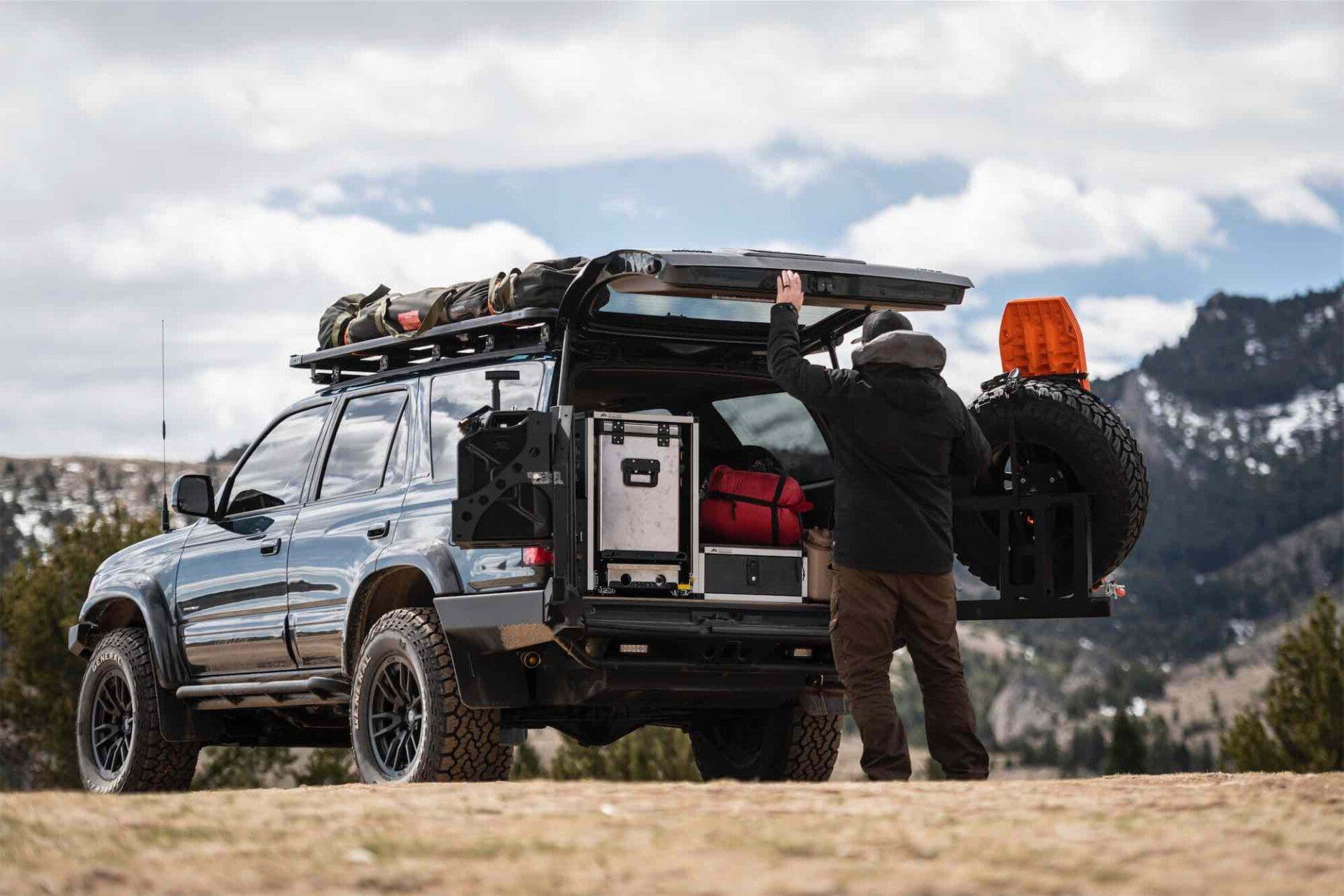
Enclosing your food and culinary items within your vehicle at the end of the day or when you leave camp is generally regarded as safe and legal practice in bear country.
As of the writing of this blog, we are awaiting a response from our local Forest Service District Ranger’s Office to see if we can gain more information and clarification on how food storage orders affect overlanders, exactly.)
Why all the Legality?
What you need to keep in mind when considering bear management practices as instituted by the federal government (through the U.S. Fish and Wildlife Service) is that the laws governing your behavior around bears are there to protect the bears as well as the people recreating within their habitat. Therefore, in designated “Bear Country” on national forest lands within the U.S., food storage laws are in place to protect the bears from being rewarded by coming into campsites and rummaging through human belongings.
The facts are that usually when a bear becomes habituated to obtaining food by means of coolers, garbage, and other consumable human-generated items, that bear ultimately needs to be euthanized. This is due to the increased threat posed to humans as the result of these newly developed repeated behaviors of the bears that keep them around human beings.
Looking at some recent statistics, in Colorado alone, 120 bears were euthanized and 89 relocated in 2020 largely as the result of the bears having become habituated to garbage.
The I.G.B.S.T. (Interagency Grizzly Bear Study Team), which keeps an eye on Grizzly Bear populations in and around The Greater Yellowstone Ecosystem, reported the death of 61 Grizzly Bears in 2021 with causes ranging from vehicle strikes, drownings in canals, and euthanasia due to problem behaviors around livestock and people.
Examining the statistics that reflect the outcome of human-bear conflicts, it is clear that it is incumbent upon us as recreationalists to be good stewards of the lands in which we recreate. That includes doing our best to manage our impact in bear habitat so as not to create problems for both humans and bears.
The absolute best resource for learning about how to effectively manage how you recreate in bear country–especially in Grizzly Bear habitat–is the I.G.B.C. website. All current regulations affecting travel and recreation in Grizzly Bear country can be found here, along with well-researched approaches to staying safe, keeping a clean camp, and preventing the creation of problem bears.
WEAPONS AND APPROACHES TO DEFENDING YOURSELF FROM A BEAR ATTACK
The best defense against Grizzly bears and bears of all kinds is to be smart in your camping and recreational practices to avoid a conflict in the first place. That is why the weapons below need to be seen as a “last-line-of-defense” in the truest sense of the term–no connotations or metaphors here.
What this means is that you have done your very best to avoid a conflict with a bear by following all recommended practices. Ask yourself these questions:
- Could I prove to a jury that I acted according to best practices in preventing a conflict with a bear in the first place? (It’s not a bad idea to take some quick pics of your camp area that reflect your adherence to best practices to have as evidence in the event you need it.)
- If I am recreating in Grizzly country, am I following best practices to avoid a conflict with a bear or am I doing everything incorrectly in a manner that will greatly increase the odds of me having a conflict with a bear?
Remember when choosing and deploying a weapon against a bear, that the overarching goal (at least in the eyes of the U.S. Fish and Wildlife Service) is to find a healthy path toward coexistence). That is why the use of lethal force needs to be the-last-line-of-defense.
Firearms
Are firearms effective in killing Grizzly Bears? Yes. All one needs to do is look at the decimation of the species in the Lower-48 of the United States during the late 19th and early 20th Centuries. Guns were the weapon of choice to kill thousands of bears that were deemed a menace to those trying to make a living in a wild and harsh Western landscape.

While filming Alaska: Last Frontier, our team opted for both Bear Spray and Firearms to ensure our safety in bear country.
So should you carry a gun to defend you and your loved ones in bear country? For the record, at X Overland, we prefer to carry both Bear Spray and a gun to best defend ourselves against an attacking Grizzly Bear. So our answer to the question above would be “yes” but only if you plan on completing the training necessary to safely and effectively equip yourself with a firearm. To our point, here are some items to help you develop your critical thinking around this subject:
- Guns are effective in killing bears. It is most likely that bears will eventually perish as the result of a bullet wound. In the case of a direct conflict with a human being, however, unless the person deploying the firearm is able to make a tactically sound shot and knows enough about firearms to have an appropriate firearm matched with the correct bullet/cartridge to defend against a bear, the most likely outcome will be injurious possibly even fatal to both the bear and the individual attacked by the bear.
- Assuming you have learned enough to be carrying a firearm and bullet/cartridge combination appropriate for defending yourself against a charging Grizzly, in the event of a charge (which may occur in less than a few seconds) can you draw your gun and make an effective shot in that amount of time? Such effective use of a firearm is indeed possible, but you have to obtain the proper gear and training to make it so. Put in that kind of work and you can optimize the capability of a firearm in the event that you need it. Here in Bozeman, Tactic, a company specializing in firearms training, offers a specialized course focused upon defending yourself against a Grizzly attack, including by means of both Bear Spray and firearms.
Note: The principles mentioned above apply to the use of both Bear Spray and guns. If you cannot deploy Bear Spray quickly and effectively, then it is likely that you will not be effective in using it to stop a charging bear. The point is to practice with whatever weapon you intend to use in this situation. In times of crisis, you will fall back on your training, so what does that imply if you have done no training at all?
- If you decide to carry a gun in camp and on the trail, consider the potential liability. Have you taken a course in firearm safety? These courses are often available for free through state fish and game departments and are mandatory to obtain a hunting license in some states. If you have the proper knowledge and skill set, there is much you can do to prevent the risk of a firearms accident from occurring. We highly recommend basic firearms safety training before using a gun for any purpose.
- Many guns deemed powerful enough to stop a charging Grizzly Bear are heavy and cumbersome to carry. There are lightweight options, but the recoil can feel severe to many users and affect their ability to shoot with the accuracy needed to make a tactically sound shot. If you choose to carry a firearm, we recommend you do your research and choose a gun you can easily carry and effectively deploy. If you have an effective firearm you are comfortable and accurate shooting and an effective and convenient system for carrying and deploying it, then you are much more likely to carry it with you every time you head into bear country.
- Finally, if you decide to deploy a firearm to attempt to defend yourself against a bear, are you aware of what and who is around you? Are you in an established camping area with other people and campers nearby? Where are your partners camped? Remember, it may be dark when you go to use your firearm against an attacking bear. Do you have a light system on your firearm? Will you be able to correctly identify the threat? Firearms training courses teach you how to correctly identify your target and what is around and beyond it to ensure you’re making as safe a shot as possible.
In summation, it is our opinion that a firearm can be a very effective tool to defend oneself against bears and any other form of attack be it animal or human. However, we believe that acquiring a firearm for this purpose without making the commitment to getting the necessary training to carry the firearm and deploy that firearm safely and effectively is dangerous and irresponsible.
The good news is that for those who are interested in using a firearm as a means of self-defense, there are excellent training programs available in many places throughout the country to assist you with this. The best of these programs will provide you with the knowledge and skills necessary to be safe, confident, and effective in the use of your firearm.
Bear Spray/Pepper Gas
The origin-story of a kind of mace developed specifically to defend oneself and/or others against a bear occurred just south of the XO Hangar not too far from the popular ski resort of Big Sky, Montana. A hunter was bow-hunting for elk in a popular piece of national forest in the area between Big Sky and Yellowstone Park when he was attacked by a Grizzly Bear. In an attempt to stop the bear in the middle of the attack, the man’s partner deployed a conventional can of mace which stopped the attack and caused the bear to retreat into the forest.
Though the man was severely mauled, he survived and started UDAP Industries with the mission of developing a mace-like product specifically for use against bears. He succeeded and “Bear Spray” was born.
Bear Spray is now by far the most common form of defense against bears today. It has been proven to be 93% effective in use cases. Though this is not perfect, it’s close.
For the average person camping and recreating in bear country, Bear Spray is widely available, relatively inexpensive (compared to a firearm), easy to carry, and easy to deploy.
That being said, like a firearm, we recommend that if you are going to carry Bear Spray you study up on how to use it, carry it, and store it. More and more nowadays, trainings are even being provided free-of-charge by fish and game agencies in states where grizzly bears are common. If you find yourself accessible to one of these Bear Spray trainings, by all means go get the training. You will learn the knowledge and skills you need to deploy your Bear Spray effectively in the case of an emergency.
From all of our trainings and experience, here are a few pro-tips we can offer regarding the safe and effective use of Bear Spray:
- Don’t treat your Bear Spray like you would Bug Spray, meaning don’t attempt to spray it on your tent, around camp, or–God-forbid–yourself in order to deter a bear attack! This may sound ridiculous, but talk to any forest service ranger around here and you will find that this kind of inappropriate use of Bear Spray products frequently occurs each year! Bear Spray is no joke, and you can expect a trip to the hospital for anyone who gets accidently sprayed.
- As overlanders, we are likely to be carrying our bear spray in our vehicle as we travel. Be sure not to leave it in the direct sunlight or anywhere it can overheat within an enclosed space. Direct sunlight outside is fine, but on the dash of a vehicle or within an enclosed cab is not. There are numerous accounts of Bear Spray canisters exploding within vehicles causing significant damage. The residue alone may make it impossible to be within the cab of your vehicle afterward. UDAP makes specialized containers to protect Bear Spray canisters and to protect the surrounding area in the event of an explosion, but usually just good practice as far as storage is concerned will keep you out of trouble.
- Keep your Bear Spray where you can quickly access it. Believe it or not, many people buy Bear Spray and then place it somewhere in the bottom of their backpacks, ostensibly presuming they can retrieve it and use it if they come across an angry bear. Bear attacks usually are completely unexpected and occur in seconds. Always keep your Bear Spray where you can quickly reach it and deploy it. This goes for around camp, too. Don’t be groping around in the dark looking for your Bear Spray when the bear is near at hand.
- Best practice is to replace your Bear Spray every four years. Think of your Bear Spray canister like a battery in your vehicle: Every four to five years you’d better replace it. The battery analogy is especially for overlanders because we rely on our starter battery to work in remote locations when we most need it. The same is true with your Bear Spray because over time the pressure in the canister declines. Look for an expiration date on the canister.
Pro-tip: Go to a safe area to deploy your bear spray (not your backyard in a crowded neighborhood!), get upwind of your target, and practice deploying your expired bear spray. You will get a feel for both the release of the spray and for the short amount of time it lasts (around 7 seconds). You can also buy cans of inert Bear Spray to practice and get the feel of deploying the real thing. Here’s a very useful source to learn more about deploying Bear Spray.
- Buy the largest can of Bear Spray that you can afford. Consider having more than one bottle on your person and make sure everyone in your group is carrying Bear Spray if you plan to go hiking, fishing, etc. in Grizzly country.
- Remember that while specifically made to be a means of defense against an attacking bear, Bear Spray has been proven to be effective against moose, mountain lions, wild hogs, raccoons, coyotes, wolves and other mammals. In fact, Bear Spray has been effectively deployed as a means of defense against an ornery moose more often than against a bear. Like sow Grizzlies protecting their cubs, a cow moose protecting her calves can be highly aggressive to anything identified as threatening.
FINAL THOUGHTS ON WEAPONS AND DEFENDING YOURSELF IN BEAR COUNTRY
Being Montanans, many of us at X Overland are well-trained and have a lot of experience with firearms. Therefore, as previously mentioned, when it comes to weapons we carry when in bear country, our preferred approach is to have both Bear Spray and a firearm at the ready. This allows us to defend ourselves and others if needed while having redundancy built into our defense plan.
We believe in staying up-to-date on the latest research concerning best practices while in bear country, and we train regularly with whatever weapons we intend to use in the event of a conflict.
We believe in traveling as a team or at least with a competent partner. If everyone in the group has received proper training for the tools they are carrying and everyone understands the safety and defense protocols put in place then everything possible has been done to mitigate the risk of a bad outcome occurring in the event of a confrontation with a bear.

When camping and traveling through bear country as an overlander, knowledge is power. Learn all you can and stay informed.
SOME ADDITIONAL TIPS FOR OVERLANDERS IN BEAR COUNTRY
There is a lot to cover in the subject of overlanding through bear country. We know we can’t get to everything, but here are a few extra pro-tips for overlanders we think worth sharing:
If available, use provided “Bear Boxes” for food storage when you are in a camp. These bear proof boxes are becoming more ubiquitous throughout established campgrounds within bear habitat. They are easy to use if you lack your own means of bear-proofing food and kitchen supplies.
Be aware of how you manage your “gray water,” and consider how draining gray water could attract animals to your camp. (By “gray water,” we mean water generated from doing dishes, washing your hands, showering, etc.) If it is legal to drain or discard your gray water, consider “sumping” your water according to best practices. (To “sump” your gray water means to dig a deep hole in which to drain and bury it.)
Consider using an electric bear fence around your camp. Bear fences don’t take up much space and can even be packed along on a motorcycle. They are proven to be highly effective in keeping bears and other large critters out of campsites and are easy to set up with a little practice. If you use a ground tent while overlanding, consider using your vehicle for bear-resistant food storage at the end of the day and then go pitch a tent with a bear fence a reasonable distance away.

Bear Fences are an easy way to ensure your safety and that of your gear and equipment.
Exercise a “fire drill” with your family and camp buddies for a bear threat in camp or on the trail. As previously mentioned, in a state of panic, we usually fall back on our training. So do some training to be ready for an emergency. What we’re talking about here is akin to doing some rescue training with avalanche beacons if you recreate often in the backcountry in winter or executing a fire drill at home.
Remember that due diligence to avoid a bear is simply good “stewardship” in the backcountry. You are doing your best to make as little impact as possible by going out of your way to avoid a harmful conflict with the wildlife you’d like to enjoy from a safe distance.
IN CONCLUSION, LET’S KEEP OUR FEARS IN CHECK
Can Grizzly Bears be frightening and have they killed people who were out camping in recreating in their habitat? Absolutely. But think of how many thousands of people die in auto accidents every year and that doesn’t keep us from heading out in our overland vehicle for a round-the-world journey.
So when it comes to overlanding amongst Grizzly Bears, let’s always start by being reasonable and by keeping our fears in check. For starters, you will likely never need to defend yourself against a bear attack. Like shark attacks, bear attacks are extremely rare and largely avoidable.
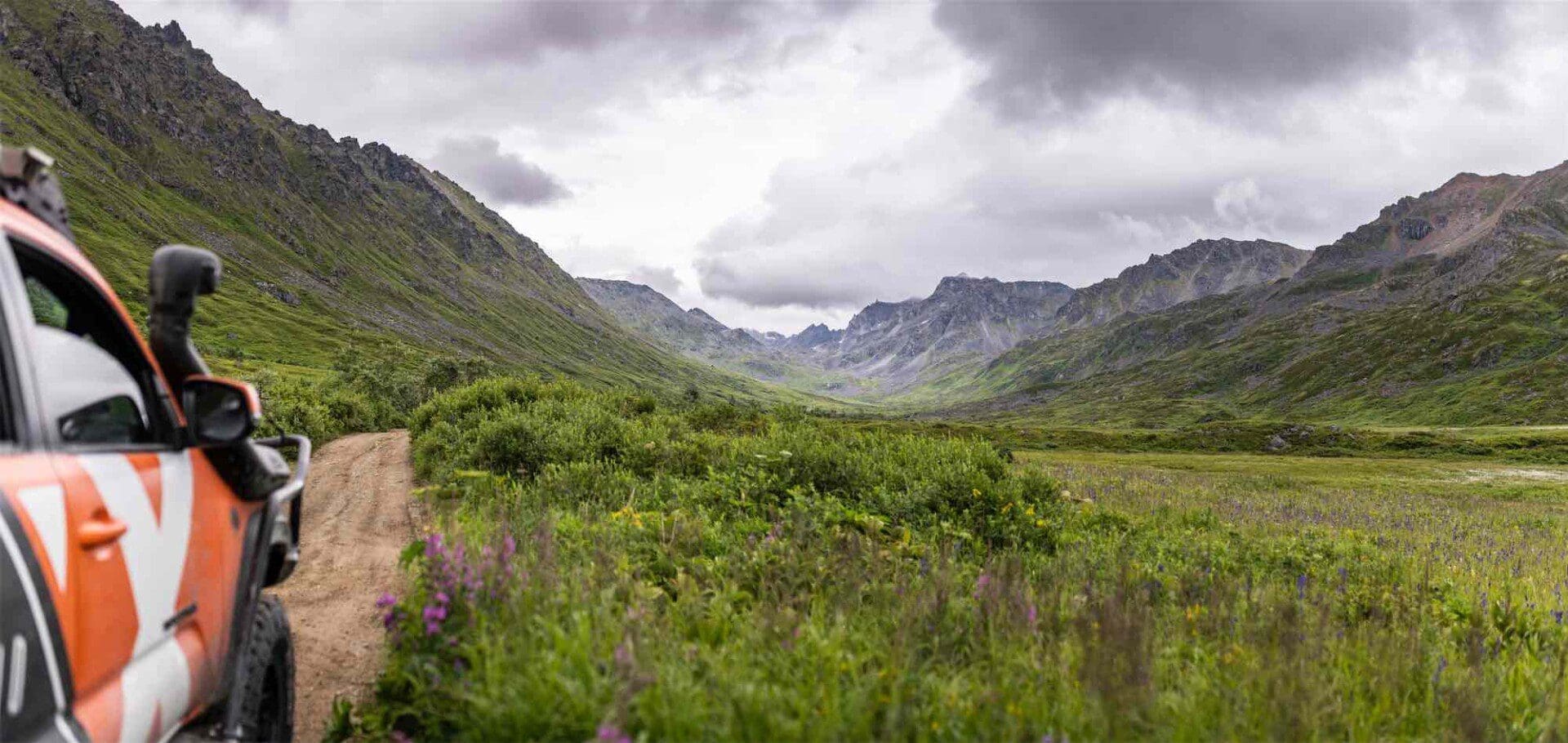
Grizzly Bears inhabit beautiful country for overlanding. Don’t let fear of bears keep you from enjoying the beautiful country they call home.
As in all things overlanding, we expect that you will not let your fear keep you from experiencing the world’s best places. We know from experience that many of those amazing places are found in Grizzly Bear country that extends from the Northern Rockies of the Lower-48 states all the way into Alaska.
Fundamentally, at X Overland we believe that knowledge and skill equal confidence and power that overcome fear and lead to a path of personal growth and truly great experiences. We take that belief to heart and aim to live by those values on the daily. We wish you happy trails in doing the same!
Helpful Resources
Interagency Grizzly Bear Committee (“I.G.B.C.”) Website
National Park Service Food Storage Recommendations for Bear Country
Best Practice for Deploying Pepper Spray and Tips for Usage
Recommended Firearms Training Program
Recommended Products
Firearm and Pepper Spray Holsters
